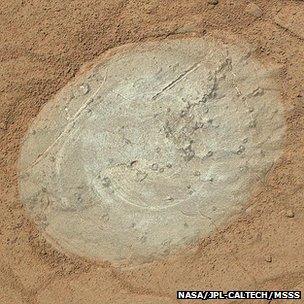Curiosity Mars rover deploys its rock brush
- Published

Nasa's Mars rover Curiosity has used its brush tool for the first time to sweep dust off the surface of a rock.
The rotating wire bristles cleared a roughly 5cm-wide patch on an area of ground dubbed "Ekwir 1" by scientists.
Brushing away the dust gives the robot's survey instruments a clearer view of the texture and chemistry of the underlying rock.
Curiosity is building towards using its hammer-drill, the last major tool yet to be deployed on the mission.
This should see action very soon, provided a suitable rock can be identified. The drill will produce a powdered sample that can be put in the robot's on-board laboratories for analysis.
The rover is currently investigating a location in Mars' Gale Crater known as Yellowknife Bay, a small depression several hundred metres from the point where it landed back in August.
It is using its mast-mounted colour cameras and laser spectrometer, together with its arm-held "hand lens" camera and X-ray spectrometer, to try to find the best drill candidate. Scientists need to be sure that when the big hammer tool turns in a rock it breaks the surface into a useable powder that will not clog or damage the sample handling mechanism.
Brushing the surface of rocks with Curiosity's dust removal tool first enables the arm-held hand lens camera and X-ray spectrometer, in particular, to see features that might otherwise be obstructed. This information could be critical in selecting the most suitable rock for drilling.
"We wanted to be sure we had an optimal target for the first use [of the dust removal tool]," said Diana Trujillo from Nasa's Jet Propulsion Laboratory.
"We need to place the instrument within less than half an inch of the target without putting the hardware at risk. We needed a flat target, one that wasn't rough, one that was covered with dust. The results certainly look good."
Curiosity has now spent more than 150 Martian days on the Red Planet.
It is trying to determine whether past environments in Gale Crater might have allowed any microbial life to flourish. Already it has identified rock deposits that were laid down in a streambed billions of years ago.
- Published4 January 2013
- Published3 January 2013
- Published4 December 2012
- Published4 December 2012
- Published10 September 2012
- Published6 August 2012
- Published25 May 2012